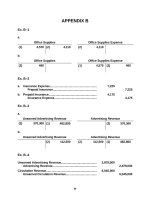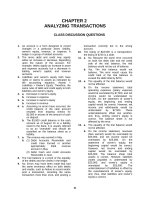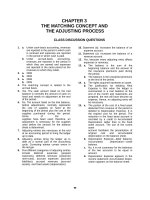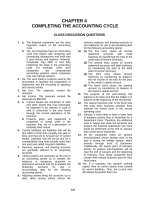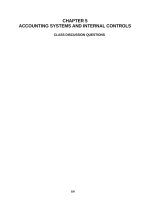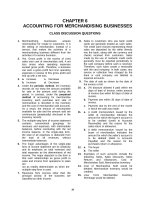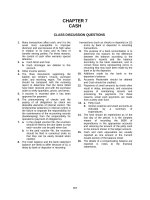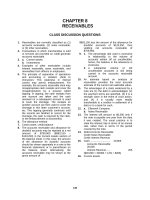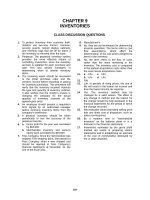Solution manual accounting 21e by warreni ch 25
Bạn đang xem bản rút gọn của tài liệu. Xem và tải ngay bản đầy đủ của tài liệu tại đây (155.82 KB, 44 trang )
CHAPTER 25
CAPITAL INVESTMENT ANALYSIS
CLASS DISCUSSION QUESTIONS
1. The principal objections to the use of the
average rate of return method are its failing
to consider the expected cash flows from
the proposals and the timing of these flows.
2. The principal limitations of the cash
payback method are its failure to consider
cash flows occurring after the payback
period and its failure to use present value
concepts.
3. The average rate of return is not based on
cash flows, but on operating income. Thus,
for example, the average rate of return will
include the impact of depreciation, but the
internal rate of return will not. In addition,
the internal rate of return approach will use
time value of money concepts, while the
average rate of return does not.
4. The cash payback period ignores the cash
flows that occur after the cash payback
period, while the net present value method
includes all cash flows in the analysis. The
cash payback period also ignores the time
value of money, which is also included in
the net present value method.
5. A one-year payback will not equal a 100%
average rate of return because the payback
period is based on cash flows, while the
average rate of return is based on income.
The depreciation on the project will prevent
the two methods from reconciling.
6. The cash payback period ignores cash
flows occurring after the payback period,
which will often include large salvage
values.
7. The majority of the cash flows of a new
motion picture are earned within two years
of release. Thus, the time value of money
aspect of the cash flows is less significant
for motion pictures than for projects with
time extended cash flows. This would favor
the use of a cash payback period for
evaluating the cash flows of the project.
8. The $9,750 net present value indicates that
the proposal is desirable because the
proposal is expected to recover the
investment and provide more than the
minimum rate of return.
9. The net present values indicate that both
projects are desirable, but not necessarily
equal in desirability. The present value
index can be used to compare the two
projects. For example, assume one project
required an investment of $10,000 and the
other an investment of $100,000. The
present value indexes would be calculated
as 0.5 and 0.05, respectively, for the two
projects. That is, a $5,000 net present
value on a $10,000 investment would be
more desirable than the same net present
value on a $100,000 investment.
10. The computations for the net present value
method are more complex than those for
the methods that ignore present value.
Also, the method assumes that the cash
received from the proposal during its useful
life will be reinvested at the rate of return
used to compute the present value of the
proposal. This assumption may not always
be reasonable.
11. The computations for the internal rate of
return method are more complex than
those for the methods that ignore present
value. Also, the method assumes that the
cash received from the proposal during its
useful life will be reinvested at the internal
rate of return.
12. Allowable deductions for depreciation.
13. The life of the proposal with the longer life
can be adjusted to a time period that is
equal to the life of the proposal with the
shorter life.
14. The major advantages of leasing are that it
avoids the need to use funds to purchase
assets and reduces some of the risk of loss
if the asset becomes obsolete. There may
also be some income tax advantages to
leasing.
15. The speed-up of delivery of products,
higher production quality, and greater
manufacturing flexibility are examples of
qualitative
factors
that
should
be
considered.
16. Monsanto indicated that it recognized that
the market was demanding higher product
quality that could be achieved only with a
95
large investment in process control
technology and automated laboratory
equipment. The process control technology
could reduce the variation in the size of
fibers. More uniform fibers, in turn, improve
the efficiency of the processes used by
carpet manufacturers. The local area
network (LAN) was not a stand-alone
investment, but it linked the process control
information to operators and management
via computer linkages. Thus, the LAN was
an integral part of the investment portfolio.
Monsanto
indicated
the
following
considerations in making its investment:
a. After-tax cash flows.
b. Labor savings.
c. Accepting projects that do not have a
quantifiable payback, such as enablers
that allow projects with more visible
benefits to be put into place (such as
LAN enabling the process control
technology
to
communicate
information).
d. Allowing estimates of increased sales
due to higher quality.
e. Considering inventory reductions in the
cost of savings.
f. Avoiding reactive investment but
considering the organizational vision
and long-term strategic direction in the
investment decision.
96
EXERCISES
Ex. 25–1
Testing
Equipment Centrifuge
Estimated average annual income:
$10,500 ÷ 4.....................................................................
$12,250 ÷ 5.....................................................................
$2,625
Average investment:
($42,000 + 0) ÷ 2.............................................................
($56,000 + 0) ÷ 2.............................................................
$21,000
Average rate of return:
$2,625 ÷ $21,000............................................................
$2,450 ÷ $28,000............................................................
12.5%
$2,450
$28,000
8.75%
Ex. 25–2
Average
Average annual income
=
rate
Average investment
of return
=
=
=
Average savings* − Annual depreciation − Additional operating costs
( Beginning cost + Residual value) ÷ 2
$26,000 ( $88,000 ÷ 8 ) $8,250
( $94,000 + $6,000 ) ÷ 2
$6,750
$50,000
= 13.5%
* The effect of the savings in wages expense is an increase in income.
Ex. 25–3
Average
Average annual income
=
rate
Average investment
of return
=
Annual revenues − Annual product costs *
( Beginning cost + Residual value)
÷2
=
($325 × 4,500 units)
($295 × 4,500 units)
($870,000 + $30,000) ÷ 2
=
$135,000
$450,000
= 30%
* The depreciation of the equipment is included in the factory overhead cost per
unit.
Ex. 25–4
Year 1
Initial investment.............................................
Operating cash flows:
Annual revenues (8,000 units × $36)........
Selling expenses (5% × $288,000)............
Cost to manufacture
(8,000 units × $19.55)*..........................
Net operating cash flows.....................
Total for year 1.................................................
Total for years 2–14 (operating cash flow)....
Residual value............................................
Total for last year............................................
Years 2–14
Last Year
$ 288,000
(14,400)
$ 288,000
(14,400)
$ 288,000
(14,400)
(156,400)
$ 117,200
$ (120,800)
(156,400)
$ 117,200
(156,400)
$ 117,200
$ (238,000)
$ 117,200
10,000
$ 127,200
*The fixed overhead relates to the depreciation on the equipment [($184,000 –
$10,000) ÷ 15 years ÷ 8,000 units = $1.45]. Depreciation is not a cash flow and
should not be considered in the analysis.
Ex. 25–5
Proposal 1: $250,000 ÷ $50,000 = 5-year cash payback period.
Proposal 2: 4-year cash payback period, as indicated below.
Net Cash
Flow
Year 1..................................................$80,000
Year 2....................................................70,000
Year 3....................................................50,000
Year 4....................................................50,000
$
150,000
200,000
250,000
Cumulative
Net Cash Flows
80,000
Ex. 25–6
a.
The Liquid Soap product line is recommended, based on its shorter cash
payback period. The cash payback period for both products can be
determined using the following schedule:
Initial investment: $550,000
Liquid Soap
Net Cash
Cumulative Net
Flow
Cash Flows
Year 1
Year 2
Year 3
Year 4
Year 5
$150,000
140,000
130,000
130,000
$150,000
290,000
420,000
550,000
Net Cash
Flow
Cosmetics
Cumulative Net
Cash Flows
$110,000
110,000
110,000
110,000
110,000
$110,000
220,000
330,000
440,000
550,000
Liquid Soap has a 4-year cash payback, and Cosmetics has a 5-year cash
payback period.
b. The cash payback periods are different between the two product lines
because Liquid Soap earns cash faster than does Cosmetics. Even though
both products earn the same total net cash flow over the 8-year planning
horizon, Liquid Soap returns cash faster in the earlier years. The cash
payback method emphasizes the initial years’ net cash flows in determining
the cash payback period. Thus, the project with the greatest net cash flows in
the early years of the project life will be favored over the one with less net
cash flows in the initial years.
Ex. 25–7
a.
Year
Present Value
of $1 at 12%
1
0.893
2
0.797
3
0.712
4
0.636
Total................................................
Amount to be invested..................
Net present value...........................
Net Cash
Flow
Present Value of
Net Cash Flow
$150,000
120,000
75,000
75,000
$420,000
$ 133,950
95,640
53,400
47,700
$ 330,690
340,000
$ (9,310)
b. No. The ($9,310) net present value indicates that the return on the proposal is
less than the minimum desired rate of return of 12%.
Ex. 25–8
a.
(All amounts are in $millions.)
2006 cash flow:
Gross ticket sales.....................................................
Production cost........................................................
Marketing cost..........................................................
Net cash flow from theatrical release...........................
$125
$100
40
$ (15)
2007 home video sales:
Total sales.................................................................
Net cash margin........................................................
Net cash flow.................................................................
$ 90
× 30%
$ 27
2008 pay TV....................................................................
2009 syndication............................................................
$
20
5
Net present value:
Year
Present Value
of $1 at 20%
2006
1.000
2007
0.833
2008
0.694
2009
0.579
Net present value...........................
Net Cash
Flow
$(15)
27
20
5
Present Value of
Net Cash Flow
$(15)
22
14
3
$ 24
b. Even though the film lost money at the box office, the project was financially
successful as a whole due to additional cash flows from home video sales,
pay TV, and network TV syndication.
Ex. 25–9
a.
Cash inflows:
Hours of operation......................................
Revenue per hour........................................
Revenue per year........................................
Cash outflows:
Hours of operation......................................
Fuel cost per hour......................................
Labor cost per hour....................................
Total fuel and labor costs per hour...........
Fuel and labor costs per year.....................
1,500
× $98.00
$ 147,000
1,500
$28.00
22.00
× $50.00
Maintenance costs per year........................
Annual net cash flow..................................
b. Annual net cash flow (at the end of each of five years)...................
Present value of annuity of $1 at 10% for five periods.....................
Present value of annual net cash flows.............................................
Less: Amount to be invested.............................................................
Net present value................................................................................
(75,000)
(12,000)
$ 60,000
$ 60,000
× 3.791
$ 227,460
235,000
$ (7,540
c. No. Crowe should not accept the investment because the bulldozer cost
exceeds the present value of the cash flows at the minimum desired rate of
return of 10%. The bulldozer might be an attractive investment if Crowe could
get a price reduction, increase the hourly revenue rate, increase the annual
hours of use, or extend the useful life of the bulldozer.
Ex. 25–10
Apartment Complex
Year
Present Value
of $1 at 15%
1
0.870
2
0.756
3
0.658
4
0.572
4
0.572
Total................................................
Amount to be invested..................
Net present value...........................
Net Cash
Flow
$
220,000
200,000
200,000
180,000
420,000
$ 1,220,000
Present Value of
Net Cash Flow
$ 191,400
151,200
131,600
102,960
240,240
$ 817,400
(775,000)
$ 42,400
Office Building
Year
Present Value
of $1 at 15%
1
0.870
2
0.756
3
0.658
4
0.572
Total................................................
Amount to be invested..................
Net present value...........................
Net Cash
Flow
$
300,000
300,000
275,000
275,000
$ 1,150,000
Present Value of
Net Cash Flow
$ 261,000
226,800
180,950
157,300
$ 826,050
(775,000)
$ 51,050
The net present value of both projects are positive; thus, both proposals are
acceptable. However, the net present value of the office building exceeds that of
the apartment complex. Thus, the office building should be preferred if there is
enough investment money for only one of the projects.
Note to Instructors: Since the investment amount is the same, the net present
value can be compared to determine preference. That is, the present value index
will show the same preference ordering.
Ex. 25–11
Initial investment to develop a restaurant unit...............
Less: Initial franchise fee.................................................
Net investment..................................................................
Years 1–10
Royalty:
Average unit revenue................................................
Royalty rate................................................................
Royalty cash flow.............................................................
Annual lease and other cash flows.................................
Total annual cash flows...................................................
Present value of a $1 annuity for 10 years at 10%
(Exhibit 2)...................................................................
Present value of annual cash flows................................
$ 1,993,000
300,000
$ 1,693,000
$1,500,000
×
4.5%
$
$
×
6.145
$ 1,490,163
Lease purchase option.....................................................
Present value of $1 for 10 years at 10% (Exhibit 1)........
Present value of lease purchase option.........................
$
×
$
Net present value per restaurant unit.............................
$
1
67,500
175,000
242,500
600,000
0.386
231,600
28,7631
–$1,693,000 + $1,490,163 + $231,600. Thus, the restaurant exceeds IHOP’s
minimum rate of return objective.
Note to Instructors: This problem is developed from the perspective of IHOP, the
franchiser. The franchisee’s present value calculation would be determined from
the present value of the net annual cash inflows from operating the restaurant
(including the cost of royalties and lease payments) as compared to the cash
outflows for the initial franchise fee and lease purchase option.
Ex. 25–12
a.
Revenues (3,000 × 80% × 300 days × $310).................................
Less: Variable expenses (3,000 × 80% × 300 days × $75).........
Fixed expenses (other than depreciation).......................
Annual net cash flow.....................................................................
$ 223,200,000
54,000,000
78,000,000
$ 91,200,000
b. Present value of annual net cash flows ($91,200,000 × 5.65).....
Present value of salvage value ($85,000,000 × 0.322).................
Total present value........................................................................
Initial investment...........................................................................
Net present value...........................................................................
$ 515,280,000
27,370,000
$ 542,650,000
510,000,000
$ 32,650,000
c.
Annual cash flow assuming $320 revenue per cruise day:
Revenues (3,000 × 80% × 300 days × $320).................................
Less: Variable expenses (3,000 × 80% × 300 days × $75).........
Fixed expenses (other than depreciation).......................
Annual net cash flow.....................................................................
$ 230,400,000
54,000,000
78,000,000
$ 98,400,000
Net present value calculation at 15% minimum rate of return:
Present value of annual net cash flows ($98,400,000 × 5.019). . .
Present value of salvage value ($85,000,000 × 0.247).................
Total present value........................................................................
Initial investment...........................................................................
Net present value...........................................................................
$ 493,869,600
20,995,000
$ 514,864,600
510,000,000
$ 4,864,600
The net present value is positive. Thus, the increase in price is sufficient to
earn a 15% rate of return.
Ex. 25–13
Present value index =
Total present value of net cash flow
Amount to be invested
Present value index of Proposal A:
$308,256
= 0.96
$321,100
Present value index of Proposal B:
$158,895
= 1.07
$148,500
Ex. 25–14
a.
Annual net cash flow—
Sewing Machine:
$75,000 = 2,000 hours × 50 baseballs × $0.75
Annual net cash flow—
Packing Machine:
$32,000 = 1,600 × $20 labor cost saved per hour
Sewing Machine:
Annual net cash flow (at the end of each of eight years).................
Present value of an annuity of $1 at 15% for 8 years (Exhibit 2).....
Present value of annual net cash flows.............................................
Less amount to be invested...............................................................
Net present value................................................................................
$ 75,000
× 4.487
$336,525
311,600
$ 24,925
Packing Machine:
Annual net cash flow (at the end of each of eight years).................
Present value of an annuity of $1 at 15% for 8 years (Exhibit 2).....
Present value of annual net cash flows.............................................
Less amount to be invested...............................................................
Net present value................................................................................
$ 32,000
× 4.487
$143,584
126,690
$ 16,894
b. Present value index =
Total present value of net cash flow
Amount to be invested
Present value index of the sewing machine:
Present value index of the packing machine:
$336,525
= 1.08
$311,600
$143,584
= 1.13
$126,690
c. The present value index indicates that the packing machine would be the
preferred investment, assuming that all other qualitative considerations are
equal. Note that the net present value of the sewing machine is greater than
the packing machine’s. However, the sewing machine requires a greater
investment than the packing machine, for very little extra net present value.
Thus, the present value index indicates the packing machine is favored.
Ex. 25–15
a.
Average rate of return on investment:
$46,880 *
= 20%
$468,800 ÷ 2
* The annual earnings are equal to the cash flow less the annual depreciation
expense, shown as follows:
$93,760 – ($468,800 ÷ 10 years) = $46,880
b. Cash payback period:
c.
$468,800
= 5 years
$93,760
Present value of annual net cash flows ($93,760 × 5.65*)................
$529,744
Amount to be invested.......................................................................
468,800
Net present value................................................................................
$ 60,944
*Present value of an annuity of $1 at 12% for 10 periods from chapter table.
Ex. 25–16
a.
Present value factor for an
annuity of $1 for 8 periods =
Amount to be invested
Annual net cash flow
=
$74,520
$15,000
=
4.968
b. 12%
Ex. 25–17
Equal annual savings per year:
$250,000,0 00
= $83,333,333
3
Present value of an annuity factor:
$190,250,0 00
= 2.283
$83,333,33 3
Go to row three in Exhibit 2. In row three, the column associated with the factor
2.283 is 15%. Thus, the internal rate of return under these assumptions is 15%.
Ex. 25–18
a.
Delivery Truck
Cash received from additional delivery (40,000 bags × $0.35)........
Cash used for operating expenses (16,000 miles × $0.32)...............
Net cash flow for delivery truck.........................................................
Present value factor for an
annuity of $1 for 6 periods =
$14,000
5,120
$ 8,880
Amount to be invested
Annual net cash flow
=
$36,506
$8,880
=
4.111
Internal Rate of Return = 12% (from text Exhibit 2)
Bagging Machine
Direct labor savings (2.0 hrs./day × $14/hr. × 260 days/yr.)..............
Present value factor for an
annuity of $1 for 6 periods =
Amount to be invested
Annual net cash flow
=
$27,555
$7,280
=
3.785
Internal Rate of Return = 15% (from text Exhibit 2)
$7,280
Ex. 25–18
Concluded
b. To: Management
Re: Investment Recommendation
An internal rate of return analysis was performed for the delivery truck and
bagging machine investments. The internal rate of return for the bagging
machine is 15%, while the delivery truck is 12% (detailed analysis available).
In addition, there do not appear to be any qualitative considerations that
would favor the delivery truck. Therefore, the recommendation is to invest in
the bagging machine. If additional funds become available, however, the
delivery truck would be an acceptable investment because the internal rate of
return of 12% exceeds the company’s minimum rate of return of 11%.
Ex. 25–19
a.
Present value of annual net cash flows ($18,500 × 4.16*)................
Amount to be invested.......................................................................
Net present value................................................................................
$76,960
84,434
$(7,474)
*Present value of an annuity of $1 at 15% for 7 periods from text Exhibit 2.
b. The rate of return is less than 15% because there is a negative net present
value.
c. Present value factor for an annuity of $1 =
Internal rate of return
Amount to be invested
Annual net cash flow
=
$84,434
$18,500
=
4.564
=
12% (from text Exhibit 2)
Ex. 25–20
With an expected useful life of 4 years, the cash payback period could not be
greater than 4 years. This would indicate that the cost of the initial investment
would not be recovered during the useful life of the asset. However, there would
be no average rate of return in such a case because a net loss would result. If the
25% average rate of return and useful life are correct, the cash payback period
must be less than 4 years. Alternatively, if both the 25% average rate of return and
4.5 years for the cash payback period are correct, the machinery must have a
useful life of more than 4 years.
Ex. 25–21
a.
Since all the cash flows are incurred in the local economy under this
assumption, it is likely that the internal rate of return of the new plant will
decline. This is because the cash profits earned on the plant will be less in
U.S. dollars as a result of the devaluation. For example, if the product sold for
a profit of 10 units of local currency, it would need to double to 20 units of
local currency in order to generate the same U.S. dollars of profit. This could
be done with a large price increase. However, such a price increase would
probably significantly reduce demand. If the price stayed the same, then the
number of U.S. dollars earned in profit would be halved.
b. If the plant produced for export only, then the expenses would be incurred in
local currency, while the revenues would be earned in U.S. dollars. This could
work in favor of the project because the expenses in U.S. dollar terms would
decline. For example, if the local wages were 16 units of local currency per
hour, then after the devaluation, these 16 units would cost half as much in
U.S. dollar terms (from $4 to $2). Since the product is sold in the United
States, the currency exchange rate would have no impact on revenues. The
net result is that the cash flows in U.S. dollar terms would potentially
increase, increasing the internal rate of return.
PROBLEMS
Prob. 25–1A
1.
a. Average annual rate of return for both projects:
$220,000 ÷ 5
$44,000
=
( $550,000 + $0 ) ÷ 2 $275,000 = 16%
b. Net present value analysis:
Year
Net Cash Flow
Present Value of
Tracking
$1 at 12%
Warehouse Technology
1
0.893
$154,000
$135,000
2
0.797
154,000
145,000
3
0.712
154,000
155,000
4
0.636
154,000
165,000
5
0.567
154,000
170,000
Total................................ $770,000
$770,000
Amount to be invested.............................................
Net present value......................................................
Present Value of
Net Cash Flow
Tracking
Warehouse
Technology
$137,522
122,738
109,648
97,944
87,318
$555,170
550,000
$ 5,170
$120,555
115,565
110,360
104,940
96,390
$547,810
550,000
$ (2,190)
2. The report to the capital investment committee can take many forms. The
report should, as a minimum, present the following points:
a. Both projects offer the same average annual rate of return.
b. The warehouse net present value exceeds the selected rate established for
discounted cash flows (12%), while the tracking technology does not.
Thus, considering only quantitative factors, the warehouse investment
should be selected.
Prob. 25–2A
1.
a. Cash payback period for both products: 2 years (the year in which
accumulated net cash flows equal $420,000).
b. Net present value analysis:
Year
Present
Value of
$1 at 15%
Net Cash Flow
Home &
Today’s
Garden
Teen
1
0.870
$220,000
$150,000
2
0.756
200,000
270,000
3
0.658
180,000
190,000
4
0.572
40,000
30,000
5
0.497
30,000
30,000
Total............................ $670,000
$670,000
Amount to be invested.............................................
Net present value......................................................
Present Value of
Net Cash Flow
Home &
Today’s
Garden
Teen
$191,400
151,200
118,440
22,880
14,910
$498,830
420,000
$ 78,830
$130,500
204,120
125,020
17,160
14,910
$491,710
420,000
$ 71,710
2. The report can take many forms and should include, as a minimum, the
following points:
a. Both products offer the same total net cash flow.
b. Both products offer the same cash payback period.
c. Because of the timing of the receipt of the net cash flows, the Home &
Garden magazine offers a higher net present value.
d. Both products provide a positive net present value. This means both
products would be acceptable, since they exceed the minimum rate of
return.
Prob. 25–3A
1.
Branch Office Expansion
Year
Present Value
of $1 at 20%
Net Cash
Flow
Present Value of
Net Cash Flow
1
0.833
$260,000
2
0.694
240,000
3
0.579
220,000
Total...........................................................
$720,000
Amount to be invested..................................................................
Net present value...........................................................................
$216,580
166,560
127,380
$510,520
520,000
$ (9,480)
Computer System Upgrade
Year
Present Value
of $1 at 20%
Net Cash
Flow
Present Value of
Net Cash Flow
1
0.833
$200,000
2
0.694
195,000
3
0.579
185,000
Total...........................................................
$580,000
Amount to be invested..................................................................
Net present value...........................................................................
$166,600
135,330
107,115
$409,045
380,000
$ 29,045
Install Internet Bill-Pay
Year
Present Value
of $1 at 20%
Net Cash
Flow
Present Value of
Net Cash Flow
1
0.833
$325,000
2
0.694
310,000
3
0.579
305,000
Total...........................................................
$940,000
Amount to be invested..................................................................
Net present value...........................................................................
$270,725
215,140
176,595
$662,460
625,000
$ 37,460
Prob. 25–3A
Concluded
2. Present value index =
Total present value of net cash flow
Amount to be invested
Present value index of branch office:
$510,520
= 0.98*
$520,000
Present value index of computer system:
Present value index of Internet bill-pay:
$409,045
= 1.08*
$380,000
$662,460
= 1.06*
$625,000
*Rounded.
3.
The computer system upgrade has the largest present value index. Although
the Internet bill-pay has the largest net present value, it returns less present
value per dollar invested than does the computer system upgrade, as
revealed by the present value indexes (1.08 to 1.06). (The present value index
for the branch office expansion is less than 1, indicating that it does not meet
the minimum rate of return standard.)
Prob. 25–4A
1.
a. Radio Station:
Annual net cash flow (at the end of each of four years).............
Present value of an annuity of $1 at 12% for 4 years (Exhibit 2)
Present value of annual net cash flows.......................................
Less amount to be invested..........................................................
Net present value...........................................................................
TV Station:
Annual net cash flow (at the end of each of four years).............
Present value of an annuity of $1 at 12% for 4 years (Exhibit 2)
Present value of annual net cash flows.......................................
Less amount to be invested..........................................................
Net present value...........................................................................
b. Present value index =
$
×
$
$
$ 480,000
×
3.037
$ 1,457,760
1,370,400
$
87,360
Total present value of net cash flow
Amount to be invested
Present value index of the radio station:
Present value index of the TV station:
$546,660
= 1.17*
$466,020
$1,457,760
= 1.06*
$1,370,400
*Rounded.
2.
a. Present value factor for an annuity of $1 =
Radio Station:
TV Station:
Amount to be invested
Annual net cash flow
$466,020
= 2.589
$180,000
$1,370,400
= 2.855
$480,000
b. Internal rate of return: (determined from Exhibit 2 in text)
Radio Station: 20%
TV Station: 15%
180,000
3.037
546,660
466,020
80,640
Prob. 25–4A
3.
Concluded
By using the internal rate of return method, all proposals are automatically
placed on a common basis. For example, the net present value analyses in
(1a) indicated that the net present value was greater for the TV station.
However, it was necessary to use the present value index to determine that
the radio station had a greater present value per dollar of investment (greater
rate of return). By using the internal rate of return method, it can be easily
seen that the radio station’s rate of 20% is greater than the TV station’s rate of
15%.
Prob. 25–5A
1.
Net present value analysis:
Site A:
Annual net cash flow (at the end of each of six years)....................
Present value of an annuity of $1 at 15% for 6 years (Exhibit 2).....
Present value of annual net cash flows.............................................
Less amount to be invested...............................................................
Net present value................................................................................
$140,000
× 3.785
$529,900
465,000
$ 64,900
Site B:
Annual net cash flow (at the end of each of four years)..................
Present value of an annuity of $1 at 15% for 4 years (Exhibit 2).....
Present value of annual net cash flows.............................................
Less amount to be invested...............................................................
Net present value................................................................................
$210,000
× 2.855
$599,550
465,000
$134,550
2. Net present value analysis:
Year
Present Value of
$1 at 15%
Net Cash Flow
Site A
Site B
1
0.870
$140,000 $210,000
2
0.756
140,000
210,000
3
0.658
140,000
210,000
4
0.572
140,000
210,000
Residual value........ 0.572
300,000
0
Total.............................................. $860,000 $840,000
Amount to be invested.......................................................
Net present value................................................................
Present Value of
Net Cash Flow
Site A
Site B
$121,800 $182,700
105,840
158,760
92,120
138,180
80,080
120,120
171,600
0
$571,440 $599,760
465,000
465,000
$106,440 $134,760*
*This amount differs from the net present value calculation in (1) due to
rounding error.
3.
To: Investment Committee
Both Sites A and B have a positive net present value. This means that both
projects meet our minimum expected return of 15% and would be acceptable
investments. However, if funds are limited and only one of the two projects
can be funded, then the two projects must be compared over equal lives.
Thus, the residual value of Site A at the end of period 4 is used to equalize the
two lives. The net present value of the two projects over equal lives indicates
that Site B has a higher net present value and would be a superior investment.
Prob. 25–6A
1.
Proposal A: 3-year and 4 months cash payback period, as follows:
Year
1
2
3
4 months*
Net Cash
Flow
Cumulative
Net Cash Flows
$220,000
220,000
220,000
60,000
$220,000
440,000
660,000
720,000
* The net cash flow for year 4 is $180,000. Hence, the net cash flow per month
is $15,000 ($180,000 ÷ 12). Thus, 4 months are needed to accumulate an
additional $60,000 (4 × $15,000).
Proposal B: 2-year cash payback period, as follows:
Year
1
2
Net Cash
Flow
$40,000
84,000
Cumulative
Net Cash Flows
$ 40,000
124,000
Proposal C: 3-year and 9 months cash payback period, as follows:
Year
1
2
3
9 months*
Net Cash
Flow
$80,000
80,000
80,000
60,000
Cumulative
Net Cash Flows
$ 80,000
160,000
240,000
300,000
*The net cash flow required is $60,000 out of $80,000 in year 4, or 75%. Thus,
75% of 12 mos. is 9 mos.
Proposal D: 3-year cash payback period, as follows:
Year
1
2
3
Net Cash
Flow
$80,000
80,000
65,000
Cumulative
Net Cash Flows
$ 80,000
160,000
225,000
Prob. 25–6A
2.
Continued
Proposal A: 16.7% average rate of return, determined as follows:
$60,000
$300,000 ÷ 5
=
( $720,000 + $0) ÷ 2 $360,000 = 16.7% (rounded)
Proposal B: 29% average rate of return, determined as follows:
$18,000
$90,000 ÷ 5
=
( $124,000 + $0) ÷ 2 $62,000 = 29.0% (rounded)
Proposal C: 9.3% average rate of return, determined as follows:
$14,000
$70,000 ÷ 5
=
( $300,000 + $0) ÷ 2 $150,000 = 9.3% (rounded)
Proposal D: 23.1% average rate of return, determined as follows:
$26,000
$130,000 ÷ 5
=
( $225,000 + $0) ÷ 2 $112,500 = 23.1% (rounded)
